

The great nutrient collapse. Irakli Loladze is a mathematician by training, but he was in a biology lab when he encountered the puzzle that would change his life.
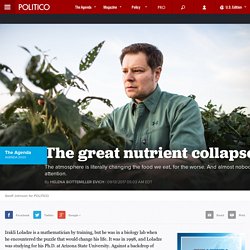
It was in 1998, and Loladze was studying for his Ph.D. at Arizona State University. Against a backdrop of glass containers glowing with bright green algae, a biologist told Loladze and a half-dozen other graduate students that scientists had discovered something mysterious about zooplankton. Zooplankton are microscopic animals that float in the world’s oceans and lakes, and for food they rely on algae, which are essentially tiny plants. Scientists found that they could make algae grow faster by shining more light onto them—increasing the food supply for the zooplankton, which should have flourished. India has planted nearly 66 million trees in 12 hours. The event took place on Sunday in Central Indian state of Madhya Pradesh.
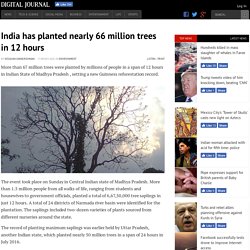
More than 1.5 million people from all walks of life, ranging from students and housewives to government officials, planted a total of 6,67,50,000 tree saplings in just 12 hours. A total of 24 districts of Narmada river basin were identified for the plantation. The saplings included two-dozen varieties of plants sourced from different nurseries around the state. The record of planting maximum saplings was earlier held by Uttar Pradesh, another Indian state, which planted nearly 50 million trees in a span of 24 hours in July 2016. Research suggests eating beans instead of beef would sharply reduce greenhouse gasses. The crew of cyclists turning Florida’s lawns into farms. The future of the immaculate British lawn is under threat, claims a new report from the Royal Horticultural Society: rising temperatures will deliver a triple-threat of dryness, weeds and pests that gardeners will have to navigate if they want to maintain their manicured emerald rectangles.
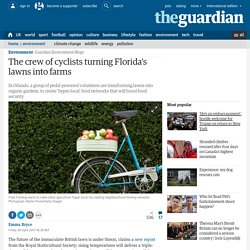
Some reports have even suggested we do away with lawns altogether and just substitute them with fake green turf (gasp!) To avoid the inevitable hassle. But will it be worth it? Let’s be honest, what do lawns really do, anyway—other than satisfy that odd part of the human ego that thrives off the sight of evenly-clipped grass? In fact, how about we really shake things up and just turn our lawns into vegetable patches, instead? That’s the idea behind Fleet Farming, a group of amateur farmers in Florida who are slowly transforming people’s lawns into food gardens in the city of Orlando. Their approach is simple. Decoding Demand for Local Food - Part 2 (Health) In our current series, Localize is exploring the underlying drivers behind local food preferences and the characteristics of local food that are grabbing the attention — and dollars — of consumers.

Check out the first post in the series where we discuss: How to give consumers what they want when there is no single definition of 'local.' How local product labeling differs from from fresh to center-store. In this post, we are discussing Health as one of five underlying attributes that drives local product purchasing. There is no concrete evidence that eating local results in better health.
. • Plant Variety: Large farms prioritize planting crops that offer the highest yeild, grow the quickest, and survive the best when transported long-distances.[2] Short and bitter-sweet — they are choosing quantity over nutritional quality. In 2008, Montclair State University found that locally sourced broccoli had double the vitamin C content compared to broccoli that had to travel far distances.[5] Cowspiracy: stampeding in the wrong direction. By focusing on veganism to the exclusion of all else, Cowspiracy implies that anyone who eats meat isn’t a ‘proper’ environmentalist.
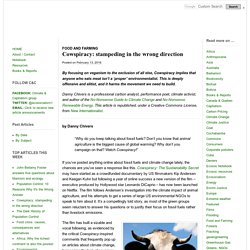
This is deeply offensive and elitist, and it harms the movement we need to build. Danny Chivers is a professional carbon analyst, performance poet, climate activist, and author of the No-Nonsense Guide to Climate Change and No-Nonsense Renewable Energy. This article is republished, under a Creative Commons License, from New Internationalist. by Danny Chivers “Why do you keep talking about fossil fuels? If you’ve posted anything online about fossil fuels and climate change lately, the chances are you’ve seen a response like this. Allan Savory: How to fight desertification and reverse climate change. Köppen climate classification. Climate classification system An updated Köppen–Geiger climate map[1] The Köppen climate classification is one of the most widely used climate classification systems.
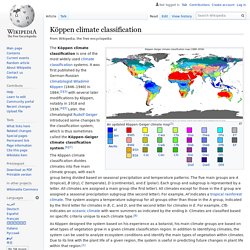
It was first published by the German-Russian climatologist Wladimir Köppen (1846–1940) in 1884,[2][3] with several later modifications by Köppen, notably in 1918 and 1936.[4][5] Later, the climatologist Rudolf Geiger introduced some changes to the classification system, which is thus sometimes called the Köppen–Geiger climate classification system.[6][7] The Köppen climate classification divides climates into five main climate groups, with each group being divided based on seasonal precipitation and temperature patterns. The five main groups are A (tropical), B (dry), C (temperate), D (continental), and E (polar). As Köppen designed the system based on his experience as a botanist, his main climate groups are based on what types of vegetation grow in a given climate classification region. Overview[edit] Group B: Dry climates. The ethical wardrobe: Is it OK to wear leather? Whether or not you chose to wear leather usually depends on your stance towards meat, be it vegan, vegetarian or carnivore.

Home — Precious Plastic. JohnnyAppl BETA - Play Trivia & Plant Real Trees. EcoGeek - Brains for the Earth.
Sustainability.